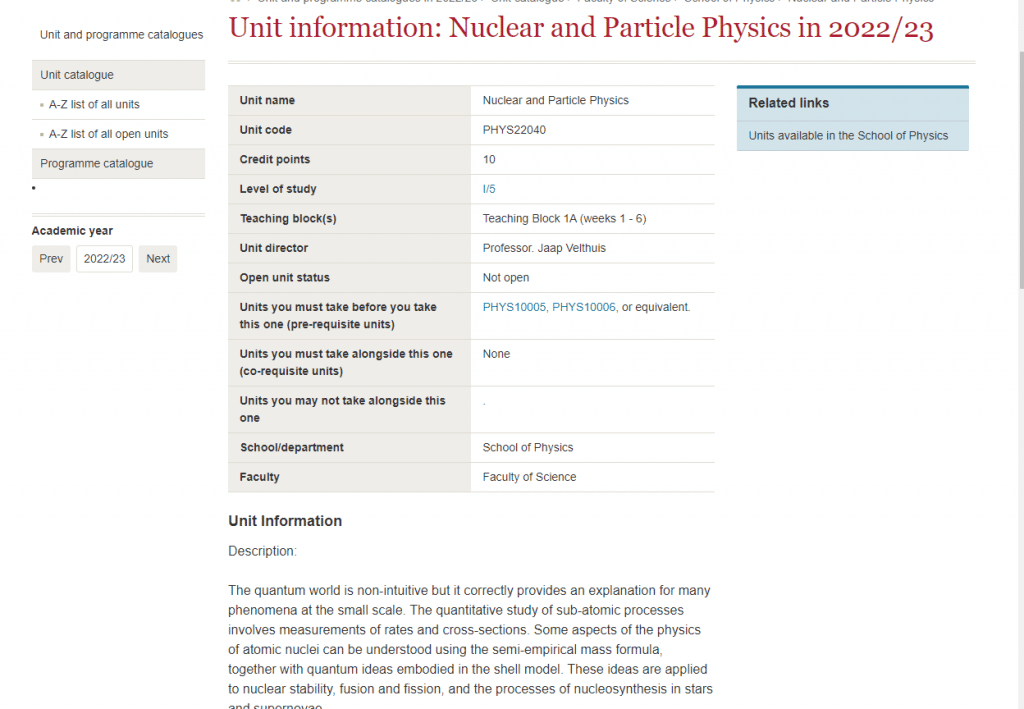Assignment-daixieTM为您提供布里斯托大学University of Bristol Foundation Nuclear and Particle Physics PHYS22040核与粒子物理学代写代考和辅导服务!
Instructions:
The quantum world operates according to different laws and principles than the macroscopic world we observe in our daily lives. At the subatomic level, particles can exist in multiple states simultaneously and exhibit behavior that seems counterintuitive. However, the principles of quantum mechanics have been shown to accurately explain and predict the behavior of particles and their interactions.
In studying sub-atomic processes, rates and cross-sections are used to measure the likelihood of certain reactions and interactions occurring. This helps us to better understand the behavior of particles and how they interact with each other.
The semi-empirical mass formula is a tool used in nuclear physics to calculate the binding energy of atomic nuclei. It takes into account the contributions from the strong nuclear force, the electromagnetic force, and the asymmetry energy. The shell model, on the other hand, is a quantum mechanical model that describes how the protons and neutrons in a nucleus are arranged in energy levels or shells.
Using these ideas, we can better understand the stability of atomic nuclei, as well as the processes of nuclear fusion and fission. We can also explore how these processes occur in stars and supernovae, leading to the formation of new elements through nucleosynthesis.

The coupling of the Higgs boson to fermions is proportional to their masses. The partial width is then proportial to the coupling squared. Calculate Higgs boson branching fractions assuming (simplifying) that only decays to bottom and charm quarks as well as to taus and muons are possible.
The partial width for Higgs decay to fermion pairs is proportional to the fermion mass squared:
$$
\Gamma_i \propto g_i^2 \propto m_i^2 .
$$
For quarks, there is a color factor of 3. So, for Higgs decay to charms (1.28 GeV), bottoms $(4.18 \mathrm{GeV})$, taus $(1.78 \mathrm{GeV})$ and muons $(0.11 \mathrm{GeV})$, the branching ratios can be calculated by:
$$
\begin{aligned}
& B r[\text { charm }]=\frac{\Gamma_c}{\Gamma_{\text {tot }}}=\frac{3 \times 1.28^2}{3 \times 1.28^2+3 \times 4.18^2+1.78^2+0.11^2}=8.1 \% \
& B r[\text { bottom }]=\frac{\Gamma_b}{\Gamma_{\text {tot }}}=\frac{3 \times 4.18^2}{3 \times 1.28^2+3 \times 4.18^2+1.78^2+0.11^2}=86.6 \% \
& B r[\text { tau }]=\frac{\Gamma_\tau}{\Gamma_{\text {tot }}}=\frac{1.78^2}{3 \times 1.28^2+3 \times 4.18^2+1.78^2+0.11^2}=5.2 \% \
& B r[\text { muon }]=\frac{\Gamma_\mu}{\Gamma_{\text {tot }}}=\frac{0.11^2}{3 \times 1.28^2+3 \times 4.18^2+1.78^2+0.11^2}=0.020 \%
\end{aligned}
$$
Charged pions, $\pi^{+}\left(\pi^{-}\right)$, can decay to electrons as well as to muons and the corresponding neutrinos. In this decay, the parity violation of the weak interaction is maximal. All arguements hold for $\pi^{+}$and $\pi^{-}$.
a)
Prepare a sketch of the pion decay at rest noting the momentum vectors as well as the spin of the involved particles. Using the sketch, discuss why you expect maximal parity violation of the weak interaction in pion decays. Following this discussion, which branching fraction is larger? Include your reasoning in the answer.
- a)
The decay, here for $\pi^{-}$, follows:
$$
\pi^{-} \rightarrow \ell^{-} \bar{\nu}_{\ell}, \quad \ell=\mu, \mathrm{e}
$$
The $\mathrm{W}^{-}$boson couples exclusively to left-handed particles and right-handed antiparticles. Since we can assume the neutrino to be massless, its chirality corresponds to its helicity. The momentum- and spin-configuration is shown in Fig 1.
b)
Show the following relation for momentum and energy, assuming that neutrinos are massless:
$$
\begin{aligned}
& p_{\ell}=\frac{m_\pi^2-m_{\ell}^2}{2 m_\pi} \
& E_{\ell}=\frac{m_\pi^2+m_{\ell}^2}{2 m_\pi},
\end{aligned}
$$
with $m_\pi=139,57 \mathrm{MeV}$ the mass of the pion and $m_{\ell}=105,66(0.511) \mathrm{MeV}$ the mass of the muon (electron).
b)
Using energy conservation, we find for pion at rest:
$$
E_\pi=m_\pi=E_\nu+E_{\ell}, \quad \text { mit: } p_\nu=p_{\ell}=p
$$
For the momentum we find:
$$
\begin{aligned}
& E_\pi=m_\pi=E_\nu+E_{\ell}, \quad \text { mit: } p_\nu=p_{\ell}=p \
& E_\pi=m_\pi=p+\sqrt{p^2+m_{\ell}^2} \
& \left(m_\pi-p\right)^2=p^2+m_{\ell}^2 \
& m_\pi^2-2 m_\pi p+p^2=p^2+m_{\ell}^2 \
& p=\frac{m_\pi^2-m_{\ell}^2}{2 m_\pi}
\end{aligned}
$$
And for the energy:
$$
\begin{aligned}
E & =\sqrt{p^2+m_{\ell}^2} \
& =\frac{1}{2 m_\pi} \sqrt{m_\pi^2-2 m_\pi^2 m_{\ell}^2+m_{\ell}^4+4 m_\pi^2 m_{\ell}^2} \
& =\frac{1}{2 m_\pi} \sqrt{\left(m_\pi^2+m_{\ell}^2\right)^2} \
E & =\frac{m_\pi^2+m_{\ell}^2}{2 m_\pi}
\end{aligned}
$$
